To hang wall decor without damaging your walls, start by evaluating your wall type and the weight of your items. For lightweight decor, use adhesive products like Command strips or adhesive hooks. If you're hanging medium to heavy pieces, secure them into wall studs with proper screws or anchors. Always verify surfaces are clean and dry for better adhesion. Utilize a stud finder and a level for accurate placement and alignment. Avoid common mistakes by following guidelines to prevent damage. If you explore further, you'll uncover a range of tips and techniques to enhance your decorating experience.
Key Takeaways
- Use adhesive products like Command strips for lightweight items, ensuring they don't exceed the 7.5 lbs weight limit to prevent wall damage.
- Identify your wall type and use appropriate hanging methods, such as wall anchors for plaster or securing into studs for heavy pieces.
- Employ wall-safe tape or adhesive hooks for small decorations to avoid leaving marks or damage on the surface.
- Ensure surfaces are clean and dry before applying adhesive solutions to enhance their effectiveness and longevity.
- Regularly inspect hung items to address any potential damage promptly and maintain wall integrity.
Importance of Damage-Free Hanging
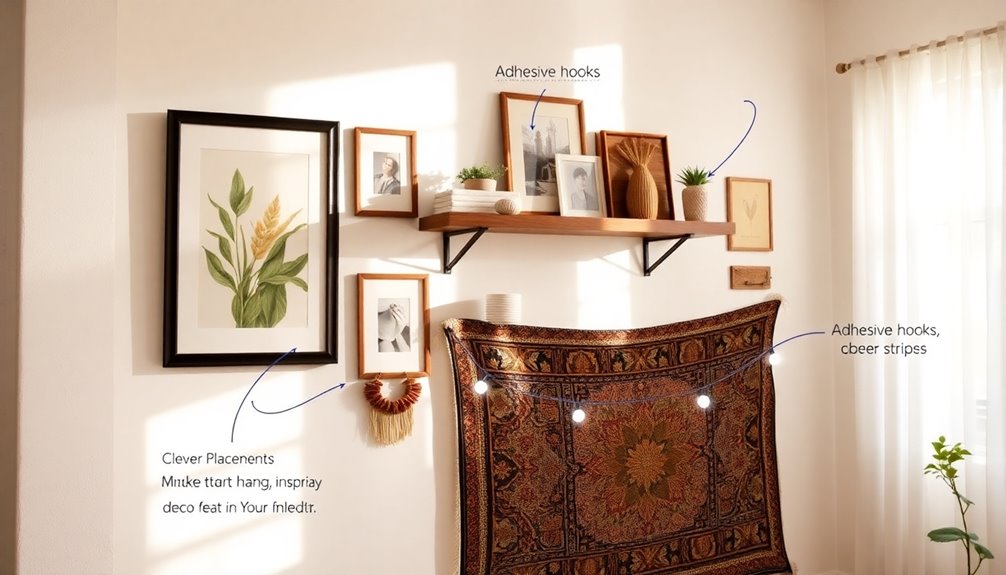
When it comes to hanging wall decor, understanding the importance of damage-free methods can't be overstated, especially if you're in a rental.
You want to hang things on walls without damaging them, and that's where damage-free hanging solutions come in. Utilizing adhesive products like Command strips allows you to securely hang lightweight items, leaving no marks or damage when removed.
It's essential to know the weight limits of these products, as exceeding them can lead to wall damage and failed displays.
Plus, using damage-free options not only keeps your walls intact but also gives you the freedom to change your decor without the hassle of repairs or repainting. In fact, using these methods can create a personalized space that reflects your style while maintaining the integrity of your walls.
Enjoy the flexibility of a beautiful, personalized space!
Assessing Wall Types
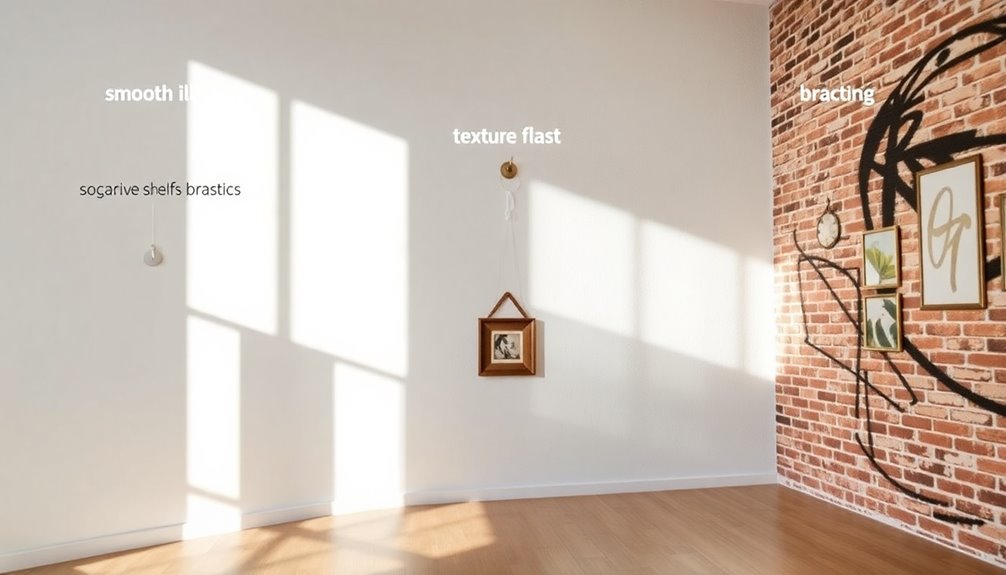
Before you hang your decor, it's crucial to identify your wall type.
Different materials like drywall, plaster, and concrete have specific weight capacities and hanging techniques.
Knowing what you're working with will help you choose the right fasteners and guarantee a secure installation.
Wall Material Identification
Identifying your wall material is essential for successfully hanging decor, as different types require specific methods and tools.
Start by determining if you have drywall, which is the most common material. You can easily insert pushpins and hear a hollow sound when tapped.
If you're dealing with plaster, often in older homes, you'll need special techniques like wall anchors or screws to avoid damage to your walls.
For steel studs, standard anchors won't cut it—you'll need specific fasteners.
Using a stud finder helps locate vertical studs behind drywall, typically spaced 16 or 24 inches apart, ensuring you have secure points for heavier items.
Proper wall material identification is key to a successful hanging project.
Weight Capacity Considerations
Understanding weight capacity is essential for safely hanging wall decor, as each wall type can support different amounts of weight.
For lightweight items under 5 lbs, adhesive solutions work well on drywall. Medium items (5-20 lbs) typically need wall anchors or screws, while heavy pieces over 20 lbs should be secured directly into wall studs.
Always check the packaging of wall anchors to guarantee they can handle the weight you plan to hang. A stud finder is invaluable for locating these studs, usually spaced 16 or 24 inches apart.
Weight Considerations
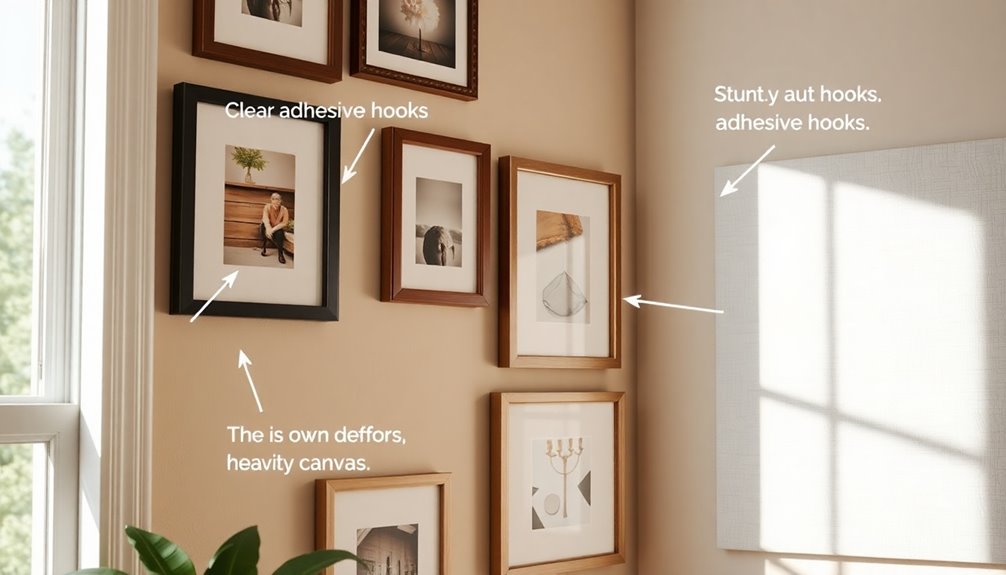
When it comes to hanging wall decor, considering the weight of your items is essential.
For lightweight pieces, adhesive solutions like Command strips work well, but for heavier items, you'll need to use wall anchors or attach directly to wall studs for secure support.
Always check weight limits to guarantee your decor stays safe and your walls remain intact.
Lightweight Item Options
Hanging lightweight decor can transform your space without the hassle of heavy tools or damaging walls.
Lightweight items, typically under 5 lbs, can easily be hung using adhesive solutions like Command strips or adhesive hooks, which provide a secure hold without causing wall damage.
Make sure your surfaces are clean and dry for the best adhesion. Allow the strips to set for the recommended time before you hang anything.
For added flexibility, consider using Velcro or magnetic strips for easy repositioning. You can also use push pins or decorative clips that leave minimal impact on your walls.
Just remember to check the weight limits on your adhesive products to avoid any mishaps!
Heavyweight Hanging Techniques
Lightweight decor can easily brighten your space, but as you move on to heavier items, the approach changes considerably. For anything over 20 lbs, always secure your pieces into wall studs for maximum support. If you can't hang directly from studs, use appropriate drywall anchors. Here's a quick reference table for common anchors:
| Anchor Type | Weight Limit | Installation Method |
|---|---|---|
| Toggle Bolts | 50+ lbs | Drill hole, insert toggle |
| Plastic Anchors | 20 lbs | Drill hole, insert anchor |
| Metal Anchors | 30 lbs | Drill hole, insert anchor |
| Screws into Studs | 100+ lbs | Directly screw into stud |
Distributing weight evenly with multiple anchors enhances stability and prevents wall damage. Use a stud finder to locate those wall studs!
Recommended Hanging Techniques
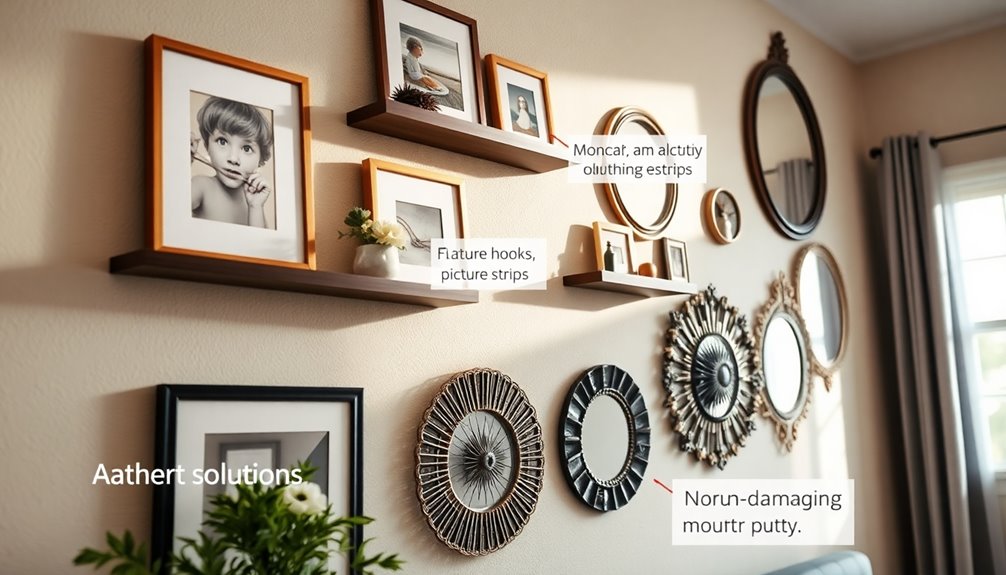
To achieve a clean and damage-free look, consider using the right hanging techniques for your wall decor.
For lightweight items, Command strips are a fantastic option. They support up to 7.5 pounds, allowing you to hang things on walls without worrying about damage.
If you're dealing with heavier pieces, make sure to hang them directly into wall studs using robust screws for secure support.
For smaller decorations, wall-safe tape or adhesive hooks work well, but verify the surface is clean and dry.
You can also use picture-hanging strips for lightweight frames, letting you reposition them easily without damaging the wall.
Tools for Successful Installation
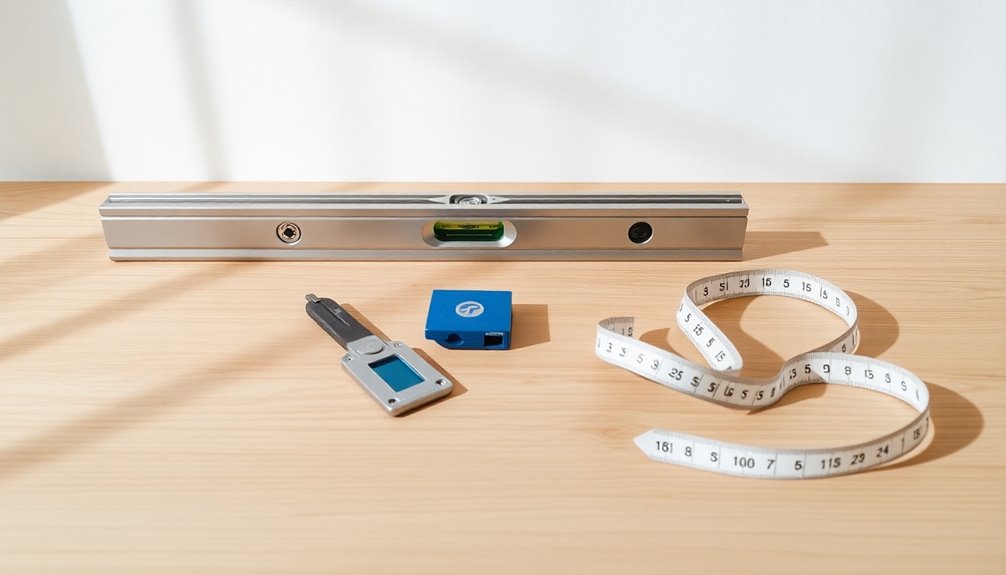
When you're ready to install your wall decor, having the right tools can make all the difference in achieving a polished look.
Consider gathering these essential tools for successful installation:
- Stud Finder: To locate wall studs for secure anchoring.
- Measuring Tape: For accurate placement and spacing of your decor.
- Level: Guarantees items are hung straight, giving a professional appearance.
- Hammer or Drill: For driving nails or installing heavier pieces into concrete walls.
Using these tools helps prevent wall damage and allows for a balanced, aesthetically pleasing arrangement.
Creative Damage-Free Solutions
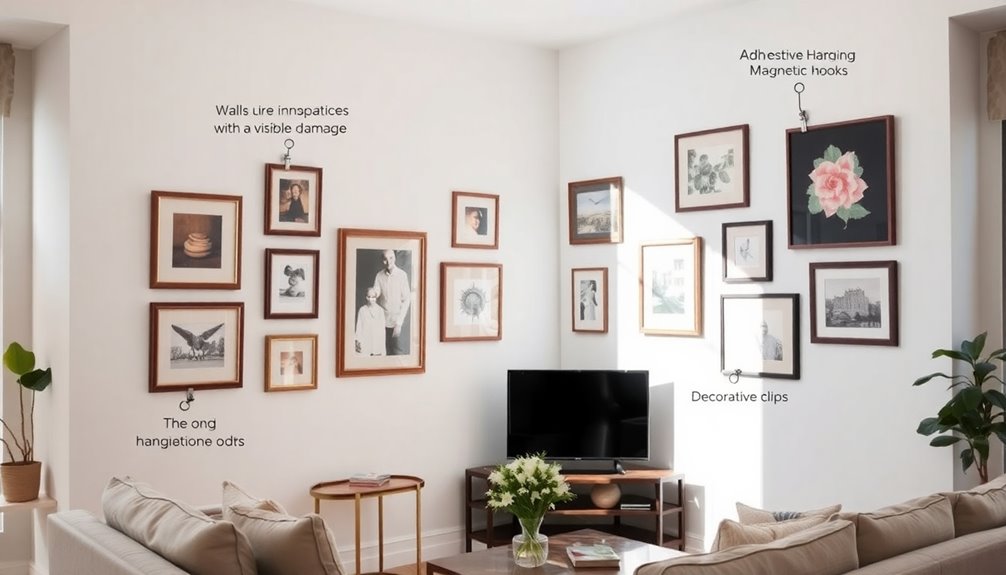
Whether you're renting or just want to avoid damaging your walls, there are plenty of creative damage-free solutions for hanging wall decor.
Command strips are a fantastic choice for hanging things, as they can hold lightweight items up to 16 pounds and leave no residue when removed.
For smaller decorations, adhesive hooks serve as a reliable damage-free option, allowing easy repositioning.
If you have metal frames, consider magnetic strips for a unique display that won't harm your walls.
Velcro strips also provide a strong hold for lightweight pieces, making them removable and repositionable.
Finally, picture hanging strips let you adjust frames effortlessly, ensuring you can change your decor without nails or screws. Additionally, using effective wall organization techniques can help create visual interest while keeping your space tidy.
Common Mistakes to Avoid
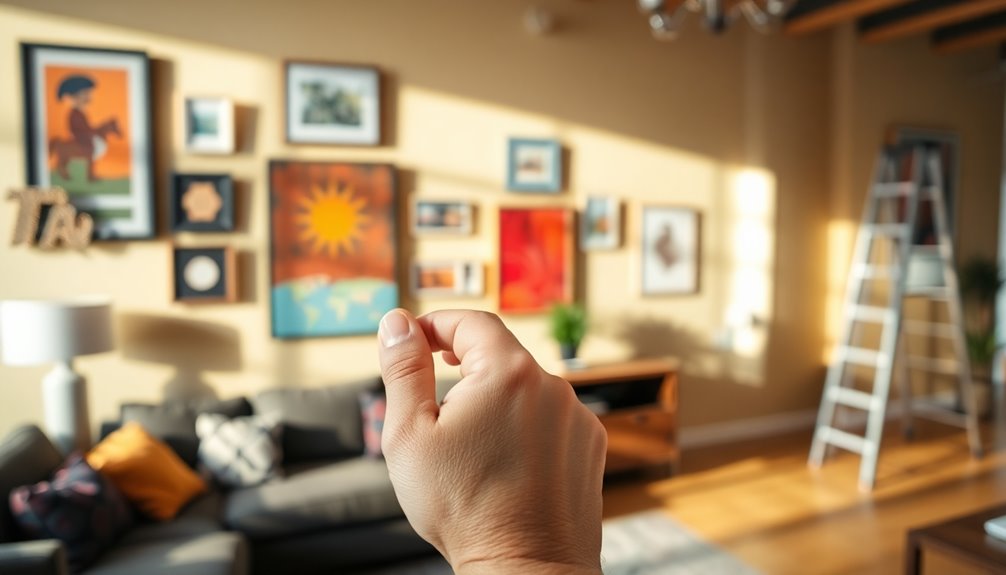
Although hanging wall decor can be a fun way to express your style, making common mistakes can quickly turn it into a frustrating experience. To avoid these pitfalls, keep these tips in mind:
- Skip the measurements: This can lead to uneven placements, making your decor look cluttered.
- Overload adhesive products: Always check weight limits; items can fall if you don't.
- Ignore wall type: Know whether your wall is drywall, plaster, or concrete to choose the right hanging method.
- Neglect weight distribution: Confirm heavier items are evenly distributed across multiple hanging points for stability.
Repairing Minor Wall Damage
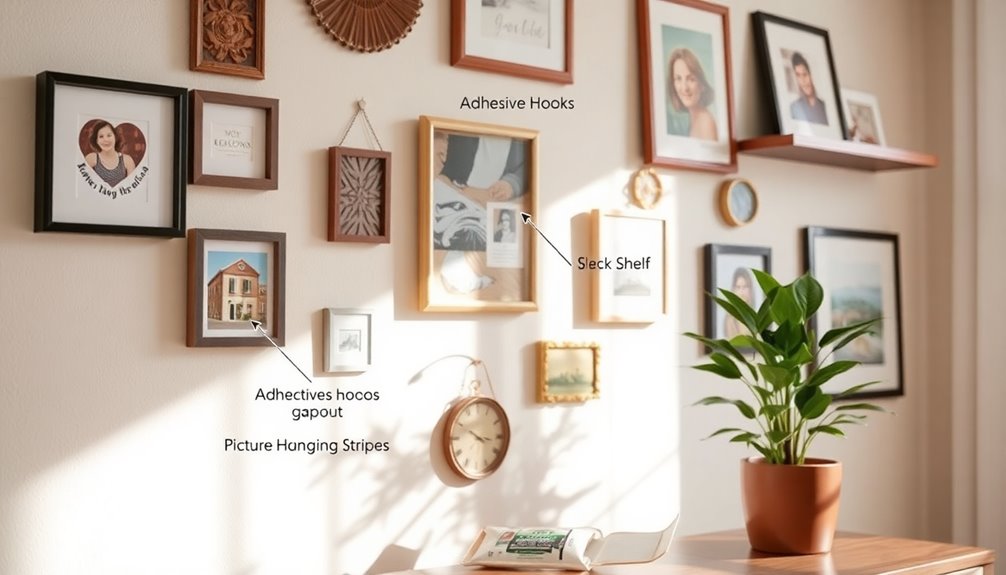
Hanging wall decor can sometimes lead to minor damage, especially if you're not careful with your placement.
If you find small nail or screw holes, you can easily fix them by using spackle. Just fill in the holes and smooth the surface with a putty knife for a flush finish.
For larger holes, apply joint compound in layers, sanding between each application until it's level with the wall. Once dry, touch up the area with paint that matches your wall color.
If you prefer a creative solution, consider using wall art or decals to cover any imperfections.
Regularly inspect your hung items for new damage, and address repairs promptly to keep your home looking its best. Additionally, maintaining a clean home can help reduce allergens and pollutants, ensuring a healthier environment while you enjoy your decor.
Additional Resources and Inspiration
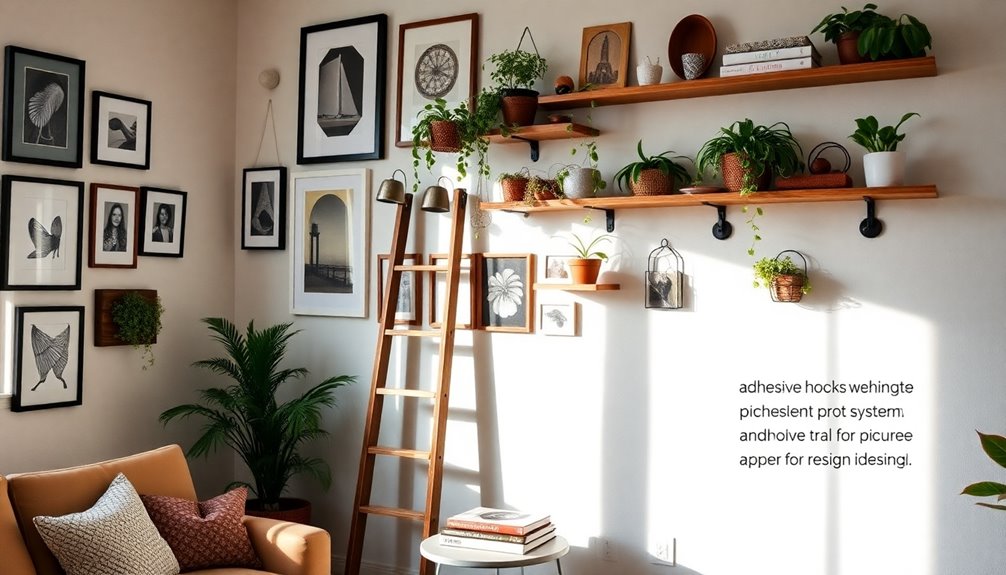
Looking for fresh ideas to elevate your wall decor? You've got plenty of resources at your fingertips!
Check out these options for inspiration and practical tips for hanging:
- Explore Pinterest and Instagram for unique wall decor ideas and innovative hanging techniques.
- Immerse yourself in home improvement blogs and YouTube channels for step-by-step tutorials on damage-free hanging methods.
- Attend local workshops or classes at community centers to gain hands-on experience in wall decor.
- Visit home improvement stores for brochures that detail various wall hanging solutions tailored to your space.
These resources will help you find creative wall decor ideas while ensuring you use effective damage-free hanging methods.
Happy decorating!
Frequently Asked Questions
How to Hang Something on the Wall Without Ruining the Wall?
If you want to hang something on the wall without ruining it, start by using damage-free options like Command strips or adhesive hooks. These innovative products allow you to easily attach and remove items without leaving residue or marks. For those interested in the best methods for hanging posters, these damage-free options provide a reliable alternative to traditional nails or tape. Additionally, they come in various sizes and strengths, making them suitable for hanging everything from lightweight posters to heavier frames.
They're perfect for lightweight items and won't leave any residue. For heavier pieces, consider wall anchors or screws directly into studs for a secure hold.
Always measure and mark your desired placement with painter's tape to avoid extra holes.
Remember to check weight limits on your hanging products to guarantee safety.
How Do You Stick Decorations to the Wall Without Damaging Them?
Ever tried to hang something without making a mark? You can stick decorations to the wall using various adhesive options.
Command strips are great for lightweight items, while adhesive hooks hold securely and remove easily.
If you've got metal-framed art, magnetic strips offer easy repositioning. Velcro strips work wonders for frames, and wall-safe tape is perfect for paper decorations.
Each method keeps your walls damage-free, letting you enjoy your decor worry-free!
How Do You Hang Wall Art Without Damaging the Wall?
To hang wall art without damaging your walls, you've got a few great options.
Use Command strips to securely attach lightweight pieces, ensuring they're rated for the weight.
For temporary displays, adhesive hooks work well without leaving marks.
If you want to reposition art often, picture hanging strips are ideal.
Magnetic strips can also help for lightweight frames, and push pins are perfect for fabric or paper decorations, minimizing wall impact.
What Adhesive Does Not Ruin Walls?
When you're looking for adhesives that won't ruin walls, consider options like Command strips and 3M's Picture Hanging Strips.
These products use special adhesives that allow for easy removal without damaging paint or leaving residue.
Adhesive hooks and wall-safe tape also work well for lightweight items, providing a secure hold while ensuring your walls remain intact.
Velcro strips can be another great choice, allowing you to reposition your decorations effortlessly.
Conclusion
Now that you've got the tips and tricks for hanging your wall decor without a hitch, imagine stepping back to admire your handiwork. Each piece of art or decor floats perfectly in place, showcasing your style without a single mark on the walls. But wait—what if a piece slips or a nail bends? Don't worry; you're prepared! With your newfound knowledge, you're ready to transform your space while keeping it pristine. Go ahead, release your creativity!









